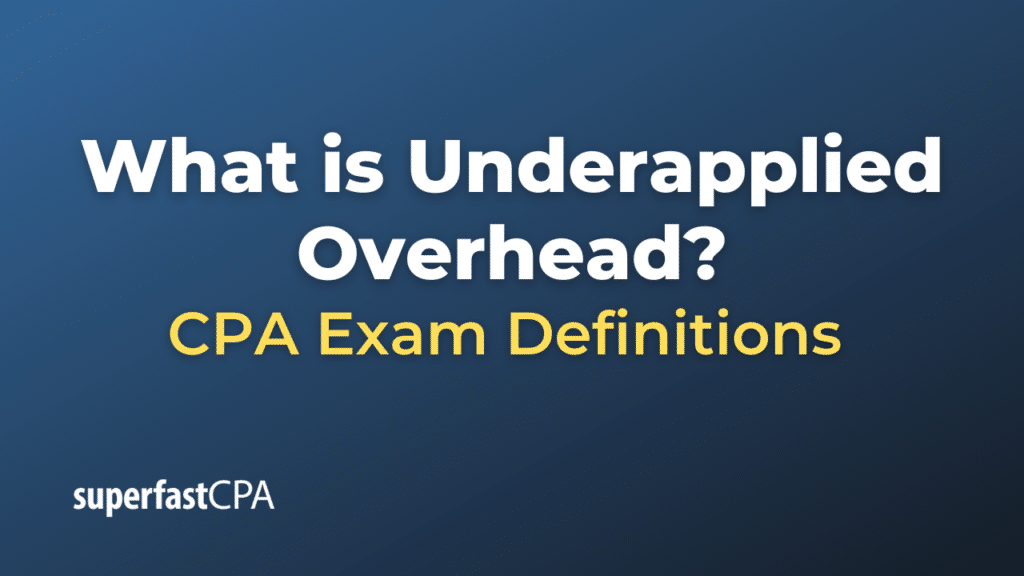Underapplied Overhead
Underapplied overhead refers to a situation where the actual manufacturing overhead costs incurred during a period exceed the manufacturing overhead costs allocated or “applied” to work-in-process inventory during that same period. In simpler terms, the company has not applied enough overhead costs to the products it has produced.
Causes:
- Lower Production Volume: If actual production is lower than anticipated, fixed overhead costs are spread over fewer units, resulting in underapplied overhead.
- Higher Actual Overhead Costs: If actual overhead costs are higher than estimated, then overhead will be underapplied.
- Inaccurate Estimation: Underapplied overhead can also occur if the initial estimated overhead rate was too low.
Financial Implications:
- Increased Costs: Underapplied overhead implies that the actual cost of goods manufactured is higher than what is reported initially.
- Profit Impact : This situation can result in overestimated profits if not adjusted, as the cost of goods sold (COGS) would be understated.
- Inventory Valuation: If not corrected, it can result in an undervaluation of ending inventory.
Accounting Adjustments:
The underapplied overhead must be allocated back to cost of goods sold, work-in-process, or finished goods inventory. This adjustment ensures that the financial statements reflect the actual costs incurred during the period.
Example of Underapplied Overhead
An example to illustrate the concept of underapplied overhead using a fictional company called “GizmoWorks,” which manufactures electronic gadgets.
Scenario
GizmoWorks estimated its annual overhead costs at the beginning of the year to be $500,000. They expected to produce 100,000 gadgets during the year, which led them to set an estimated overhead rate of:
Estimated Overhead Rate = Estimated Overhead Costs / Estimated Production Units
= $500,000 / 100,000 units = $5/unit
Actual Results
By the end of the year, GizmoWorks found that:
- The actual overhead costs incurred were $550,000.
- The actual production was 95,000 units.
Calculating Overhead Applied
First, we calculate the overhead that was actually applied to the products using the pre-determined overhead rate:
Overhead Applied = Actual Production Units x Estimated Overhead Rate
= 95,000 units x $5/unit = $475,000
Calculating Underapplied Overhead
Next, we determine the underapplied overhead amount:
Underapplied Overhead = Actual Overhead Costs – Overhead Applied
= $550,000 – $475,000 = $75,000
Financial and Accounting Adjustments
GizmoWorks now has an underapplied overhead of $75,000. This amount needs to be allocated to the appropriate accounts to ensure accurate financial reporting. The company has several options:
- Allocate Entirely to Cost of Goods Sold (COGS) : Increase COGS by $75,000. This will reduce the reported gross margin and net income.
- Allocate to Inventory: If some of the produced gadgets are still in inventory, GizmoWorks could allocate a portion of the $75,000 to the inventory value on the balance sheet.
- Allocate Across Both: GizmoWorks could also divide the $75,000 between COGS and inventory based on a reasonable method, like the number of units produced vs. the number of units sold.
Adjusting Entry for Underapplied Overhead
If GizmoWorks chooses to allocate the entire amount to COGS, the adjusting journal entry would look something like this:
- Debit Cost of Goods Sold: $75,000
- Credit Manufacturing Overhead: $75,000
This entry clears the Manufacturing Overhead account of its underapplied balance and increases the Cost of Goods Sold, thereby lowering net income by $75,000.
Understanding and addressing underapplied overhead is critical for accurate financial reporting and effective managerial decision-making.













